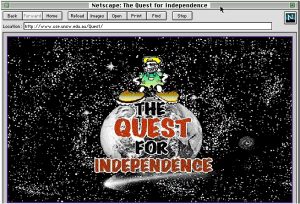The game we designed (as I talked about yesterday), Quest for Independence, was actually a fair bit of a hit. While we couldn’t talk to kids still, anecdotally we heard that the kids were playing it. And, as the design intended, it led them to talk to the Care counselors. That was good enough, but there was more.
First, the Aussie science program Quantum had a bit on it. They even interviewed me (with a big production about bringing stuff to our house), but never used the footage. They also couldn’t talk to the kids ‘in care’, but it turns out Quest was being used by kids not in care! High schools were using it to explore life after school as well. That was a nice outcome.
Another occurrence brought new action. Sometime after the game launched, I became aware of the Common Gateway Interface (CGI) standard for the web. What this did was allowed web pages to do backend processing based upon user actions, and then programmatically change the front end. In short, web pages could react based upon what had happened before.
For Quest, this meant that we could port it to the web! That is, you started the game, the player’s actions were sent to the web, the program could calculate the outcome and render an appropriate new page, with the graphics assembled to represent the game variables, the current location, and more. This was exciting.
 And, again, I had a student wanting to do a project. So the project was to take the game graphics, and the programming, and make the game web-playable. And lo, it was done; the game could be played over the web. Most wonderfully, it still can be! (Yay, standards!)
And, again, I had a student wanting to do a project. So the project was to take the game graphics, and the programming, and make the game web-playable. And lo, it was done; the game could be played over the web. Most wonderfully, it still can be! (Yay, standards!)
Naturally, I wrote it up (with the student; a principle I always stuck to: even if I usually ended up writing it all, they got credit for their work and ideas). And, as far as I know, it was the very first web-delivered serious game. At the least, without Flash.
The underlying principles in the game also became part of a couple of chapters, and ultimately the alignment between effective education and engaging experiences formed the core of my book on serious game design, Engaging Learning.
One final reflection is that working on this, on a project that really helped real kids, was still one of the most rewarding projects I’ve ever worked on. It’s nice to help clients deliver outcomes, but saving lives that were at risk? That’s just too good. Anyone up for some more ‘hard fun’?
Leave a Reply